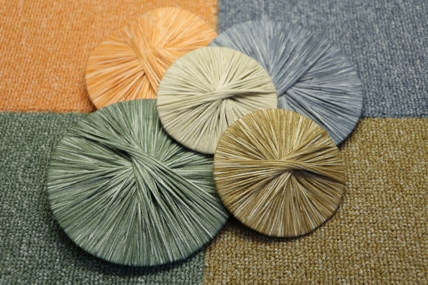What you need to know about pre- and post-consumer recycling

It is often said that in nature, there is no such thing as waste. Everything is recycled there.
The carpet industry can draw inspiration from nature’s efficient recycling systems. Recycled content in carpet products has the potential to massively reduce the amount of plastic waste that ends up on landfills or in incineration. In the industry, both pre- and post-consumer recycling are gaining momentum. But, what exactly is the difference between pre- and post-recycled content?
Take a quick look around your household, and you will realize that daily life would be hard to imagine without plastics. It’s in the packaging that keeps our food fresh, in the clothes we wear, in our furniture, carpets and countless other everyday objects. But the success of plastics – their light weight and durability – are also the material’s biggest problem. At the end of their usage, plastics typically end up as waste, remaining in the environment even when they are no longer in use.
In the currently dominant, linear economic model, we take materials from the Earth, make products from them, and we eventually dispose of them as waste. In contrast, the circular economy model aims to use closed-loop production to keep resources in play for as long as possible. In this model, there is no more plastic waste, or at least, waste plastics should be valorized again as much as possible. This also means that already in the design phase, attention should be paid to the way products can re-enter the loop at the end of their lifetime.
Pre- and post-consumer recycling
Eliminating waste is one of the most important principles of the circular economy, but there are different paths to get there.
- Post-consumer recycling: This is probably the best-known form of recycling. It refers to material generated by households or other end-users which can no longer be used for its intended purpose. Think of PET bottles which are recycled by consumers every day, sorted by recycling facilities, and processed into something new.
- Pre-consumer recycling: This is also called post-industrial recycling. It refers to the reclamation of waste that is created during the manufacturing process before it gets delivered to the consumer. Think of scraps from paper production or, closer to the carpet industry, residual materials from the production of virgin nylon.
Mechanical and chemical recycling
In addition to the stages in which waste is recycled (pre- and post-consumer), we also need to distinguish between two types of recycling technologies. Typically, we distinguish between mechanical and chemical recycling. Both technologies can be used for pre- and post-consumer waste.
- Mechanical recycling is a process in which plastics are for example shredded, melted and granulated. This is a mature approach that allows manufacturers to process large volumes of plastic waste at relatively low ecological impact. The downside of this method is that it works with waste that is often polluted from being used, or mixed with other materials, which makes it more difficult to separate into mono-materials with the same original quality. The quality of the recycled material will be lower. For example, attaining the same color quality can become problematic. In addition, the success of mechanical recycling heavily depends on the available infrastructure for collecting, sorting, pre-treating and reprocessing materials.
- Chemical recycling is the process of converting polymeric waste into its original monomers or into other valuable chemical constituents that can be used as raw materials for new products. Overall, chemical recycling can break up plastics down to their basic building blocks and therefore can create near-virgin quality recycled materials. There are different chemical recycling technologies, including thermal depolymerization (like pyrolysis or gasification); chemical depolymerization (like glycolysis, hydrolysis, methanolysis and enzymatic depolymerization) and solvent-based purification or dissolution. Chemical recycling is gaining momentum in textiles applications, such as the carpet industry. EqoCycle PA6 yarns for example has no less than 75% recycled content attributed, based on recycled and regenerated PA6 waste.
Design with the end in mind
In the carpet industry, eco-design is the new black. The idea here is that recyclability should already be taken into account from the start, right at the product’s design phase. Not an easy job for sustainability engineers, because in order to be recyclable, pre- and post-consumer waste needs to tick a lot of boxes (separability, use of mono-materials, cleanliness, etc.).

Choosing the right virgin material in light of its recyclability has now become crucial.
A material like Polyamide 6 (PA6) for example, holds great potential in the production of yarns, because it can be infinitely recycled and reused in various applications. PA6 is produced by polymerization of caprolactam, an organic compound. PA6 waste can then be depolymerized again into its raw material caprolactam. This can be used to make new recycled granulate and in a next step PA6 yarns with the same chemical and performance characteristics as those produced from fossil sources.
Ongoing quest for innovation
There are currently many certification systems to prove the use of genuine recycled material in manufacturing. The Global Recycled Standard (GRS) and ISCC Plus are two important standards in the plastics industry, but there are many more, and they may vary from industry to industry.
The recycling discussion is far from over. The quest for innovation is still in full force. One thing is certain: to successfully reduce waste on landfills and in incineration, the industry will need to consider all possible waste streams. And we will need to keep our eyes open for new ways to reduce, reuse and recycle materials. Both post-industrial and post-consumer recycling will be valuable and will play an important role in driving the circular economy forward. This will require a concerted effort from all players in the value chain.